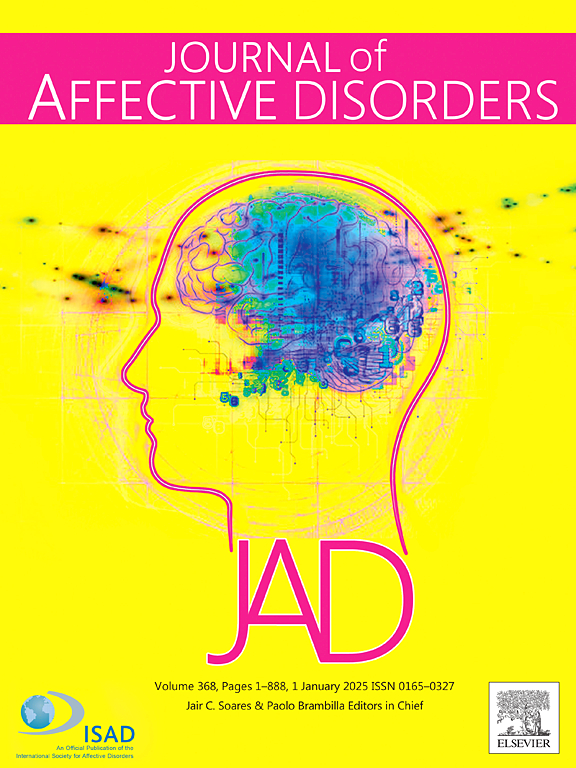Prevalence, risk factors and family dynamics of antenatal depression in couples: A multicenter cross-sectional study
IF 4.9
2区 医学
Q1 CLINICAL NEUROLOGY
引用次数: 0
Abstract
Background
Parental depression during the perinatal period is a public health concern. This study aims to evaluate the prevalence of antenatal depression in couples, identify associated risk factors, and examine family dynamics, particularly marital and in-law relationships.
Methods
A cross-sectional, multicenter study conducted from November 2023 to June 2024 surveyed 2460 pregnant women and their partners in Anhui Province, China. The Edinburgh Postnatal Depression Scale (EPDS) was used for psychological assessment. Logistic regression identified risk factors for antenatal depression, and structural equation modeling (SEM) examined the direct and indirect effects of family relationships on antenatal depression.
Results
The prevalence of comorbid antenatal depression within couples was 3.3 %, with similar rates in women (16.4 %) and men (14.6 %). Key risk factors for both maternal and paternal depression included marital distress, unexpected pregnancy, a personal history of depression, and partner depressive symptoms. Additional risk factors for women were mother-in-law relationships, lower education, and lower household income. SEM analysis revealed that mother-in-law relationships had a direct effect on both marital distress (β = 0.69, p < 0.001) and depression in women (β = 0.15, p < 0.001). Furthermore, the indirect effect of mother-in-law relationships on maternal depression (β = 0.12, p < 0.001) was significantly stronger than that on paternal depression (β = 0.02, p < 0.001).
Conclusion
Maternal and paternal mental health during the perinatal period should be prioritized, especially in the presence of marital and in-law stressors. A family-centered care model with targeted psychological support may help mitigate antenatal depression.
夫妇产前抑郁的患病率、危险因素和家庭动态:一项多中心横断面研究
背景围产期父母抑郁是一个公共卫生问题。本研究旨在评估夫妻产前抑郁的患病率,确定相关的风险因素,并检查家庭动态,特别是婚姻和姻亲关系。方法于2023年11月至2024年6月对安徽省2460名孕妇及其伴侣进行横断面、多中心研究。采用爱丁堡产后抑郁量表(EPDS)进行心理评估。Logistic回归确定了产前抑郁的危险因素,结构方程模型(SEM)检验了家庭关系对产前抑郁的直接和间接影响。结果夫妻共患病产前抑郁发生率为3.3%,女性为16.4%,男性为14.6%。母亲和父亲抑郁的主要危险因素包括婚姻困扰、意外怀孕、个人抑郁史和伴侣抑郁症状。女性的其他风险因素是岳母关系、教育程度较低和家庭收入较低。扫描电镜分析显示,岳母关系对婚姻困扰有直接影响(β = 0.69, p <;0.001)和女性抑郁症(β = 0.15, p <;0.001)。此外,岳母关系对母亲抑郁的间接影响(β = 0.12, p <;0.001)显著强于父亲抑郁(β = 0.02, p <;0.001)。结论围产期父母亲的心理健康应受到重视,特别是在存在婚姻和姻亲压力的情况下。以家庭为中心的护理模式与有针对性的心理支持可能有助于减轻产前抑郁症。
本文章由计算机程序翻译,如有差异,请以英文原文为准。
求助全文
约1分钟内获得全文
求助全文
来源期刊

Journal of affective disorders
医学-精神病学
CiteScore
10.90
自引率
6.10%
发文量
1319
审稿时长
9.3 weeks
期刊介绍:
The Journal of Affective Disorders publishes papers concerned with affective disorders in the widest sense: depression, mania, mood spectrum, emotions and personality, anxiety and stress. It is interdisciplinary and aims to bring together different approaches for a diverse readership. Top quality papers will be accepted dealing with any aspect of affective disorders, including neuroimaging, cognitive neurosciences, genetics, molecular biology, experimental and clinical neurosciences, pharmacology, neuroimmunoendocrinology, intervention and treatment trials.
 求助内容:
求助内容: 应助结果提醒方式:
应助结果提醒方式:


